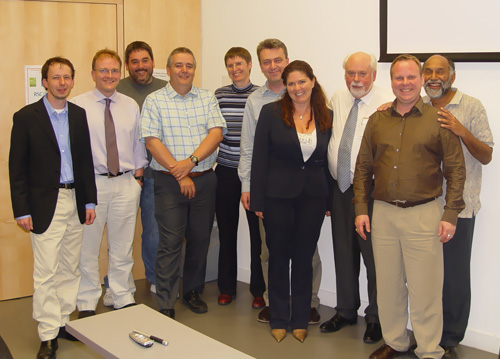The 10th Annual Symposium in Supramolecular Chemistry Showcases Innovative Research
Posted on: 01 September 2009
The 10th annual Supramolecular Chemistry Symposium, hosted by Professor Thorfinnur Gunnlaugsson and Dr Silvia Giordani of TCD’s School of Chemistry, featured presentations from eight leading scientists and represented the largest meeting of its kind in Ireland. This year, over 140 supramolecular chemists with interests in organic, inorganic, physical and biological chemistry from across Ireland and Europe attended the symposium which was held in honour of Professor Sir Fraser Stoddart, who also received an honorary doctor of science degree from TCD in July of this year.
The day long event, sponsored by the Royal Society of Chemistry (RSC), the Irish Research Council for Science, Engineering and Technology (IRCSET), the Centre for Synthesis and Chemical Biology (CSCB), Centre for Research on Adaptive Nanostructures and Nanodevices (CRANN) and Science Foundation Ireland (SFI), demonstrated the versatility of the field of supramolecular chemistry. Throughout the course of the day, pioneering discoveries from leading scientists were presented alongside poster presentations by PhD students and postdoctoral fellows as well as new work from two young academic members of TCD’s School of Chemistry.

Dr Wolfgang Schmitt, Professor Douglas Philp, Dr Stuart Cantrill, Dr Tony James, Professor Sally Brooker, Professor Donal O’Shea, Dr Silvia Giordani, Professor Sir Fraser Stoddart, Professor Thorfinnur Gunnlaugsson and Professor A P de Silva
The symposium included a plenary lecture from Professor Sir Fraser Stoddart entitled ‘Mechanostereochemistry’. In his exciting lecture Sir Fraser clearly demonstrated how the field of supramolecular chemistry has grown rapidly in the last few years, where the emphasis on developing novel functional materials and devices has been at the heart of its expansion. Speaking on the title of his lecture Sir Fraser said: ‘It encompasses all aspects of the mechanical bond in chemistry’. This new area of chemistry, which is best described as the chemistry of systems beyond the classical description of a supermolecule relating to robust mechanically interlocked components of precise form and function, highlighted Sir Fraser’s cutting edge research and broadened the scope of study for future symposiums.
Other contributers to the symposium included Professor A P de Silva, from Queen’s University Belfast, who spoke on the development of molecular sensors and logic devices entitled ‘2009: A small space odyssey with luninescent molecules’. This lecture showed that single molecules can function as a ‘molecular spy’ to detect the whereabouts and the determine the concentrations of specific analytes, such as those monitored in critical care analysis.
Professor Douglas Philp, from the University of St Andrews, Scotland, whose presentation entitled ‘Selecting one reagent from a mixture: Exploiting replication networks in dynamic covalent chemistry’, described some of his pioneering discoveries in the development of self-catalytic and self-replicating molecules, where self assembling molecules in solution form templates that function as catalysts for their own synthesis, which can be considered as an example of self selection.
In his presentation entitled ‘Combining therapeutic treatments with fluorescence imaging a theranostic approach’, Professor Donal O’Shea from UCD demonstrated groundbreaking research where a single molecule can function as a drug and an imaging agent for cancer tumours, or bacteria, such as MRSI. Furthermore he showed that these molecules, in conjunction with non-invasive and low energy light, can potentially be used in the treatments for those suffering from such illnesses.
Dr Tony James from the University of Bath, England, demonstrated in his presentation ‘Molecular recognition using boronic acids’ the power of employing boronic acid as a receptor for diols, and that this simple chemistry can be used to create novel luminescent and naked eye detection methods for monitoring sugars, such as glucoses in humans and animals, and that this application is at a very advanced stage.
Finally, within the area of inorganic supramolecular chemistry, Professor Sally Brooker, from the University of Otago, New Zealand, showed in her presentation, entitled ‘Spin crossover and anion interactions in iron (II) triazole complexes’, that the magnetism of novel metal and poly metal coordination complexes can be controlled externally by design, which allows for their potential use in future data storage, where information can be written and read on a molecular level.
